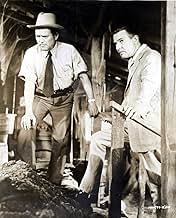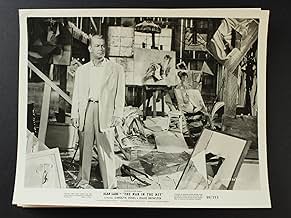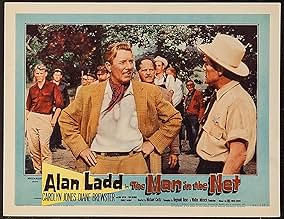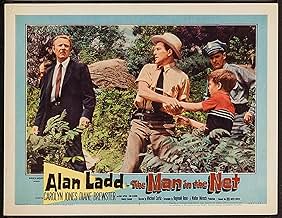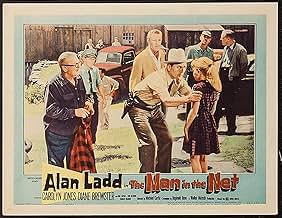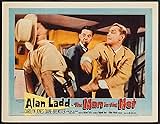ÉVALUATION IMDb
6,1/10
878
MA NOTE
Ajouter une intrigue dans votre langueA struggling artist in a small town becomes the prime suspect when his wife mysteriously disappears.A struggling artist in a small town becomes the prime suspect when his wife mysteriously disappears.A struggling artist in a small town becomes the prime suspect when his wife mysteriously disappears.
Diana Brewster
- Vickie Carey
- (as Diane Brewster)
Michael McGreevey
- Buck Ritter
- (as Mike McGreevey)
Dee Carroll
- Psychiatrist's Nurse
- (uncredited)
Bill Cassady
- State Trooper
- (uncredited)
Alvin Childress
- Alonzo
- (uncredited)
Avis en vedette
There's a nice New England feel in the Connecticut opening scenes of THE MAN IN THE NET and director Michael Curtiz makes striking visual use of the B&W camera in artfully photographing a country farmhouse with its rustic interiors full of paintings supposedly done by local artist ALAN LADD.
Ladd's wife, CAROLYN JONES, doesn't share his passion for the arts, staging quite a scene with neighbors when she breaks into a birthday party with a shiner and accuses her husband of mistreating her during one of their arguments. It provides a nice set-up for someone to eventually murder her, making Ladd look like the main suspect.
Alan Ladd, only 46 at the time, seems almost lifeless and delivers a completely stiff performance that has him befriending neighborhood kids in such a fashion that they become willing to help him avoid detection when the villagers turn on him. This aspect of the story simply rings false, as does the rest of the plot which is too pat and contrived to seem plausible. The children are not exactly adept at delivering most of their lines.
DIANE FOSTER does a nice job as a decent neighborhood woman who helps Ladd prove his innocence and CHARLES McGRAW, JOHN LUPTON and TOM HELMORE are fine as other suspects in the supporting cast.
But for a man accused of a crime he didn't commit, Ladd has all the facial animation of a department store mannequin.
Trivia note: The bit about the slashed paintings reminds me of the Ronald Colman/Ida Lupino flick THE LIGHT THAT FAILED, but Jones' emoting in the party scene is on the level of Bette Davis at her histrionic overkill.
Ladd's wife, CAROLYN JONES, doesn't share his passion for the arts, staging quite a scene with neighbors when she breaks into a birthday party with a shiner and accuses her husband of mistreating her during one of their arguments. It provides a nice set-up for someone to eventually murder her, making Ladd look like the main suspect.
Alan Ladd, only 46 at the time, seems almost lifeless and delivers a completely stiff performance that has him befriending neighborhood kids in such a fashion that they become willing to help him avoid detection when the villagers turn on him. This aspect of the story simply rings false, as does the rest of the plot which is too pat and contrived to seem plausible. The children are not exactly adept at delivering most of their lines.
DIANE FOSTER does a nice job as a decent neighborhood woman who helps Ladd prove his innocence and CHARLES McGRAW, JOHN LUPTON and TOM HELMORE are fine as other suspects in the supporting cast.
But for a man accused of a crime he didn't commit, Ladd has all the facial animation of a department store mannequin.
Trivia note: The bit about the slashed paintings reminds me of the Ronald Colman/Ida Lupino flick THE LIGHT THAT FAILED, but Jones' emoting in the party scene is on the level of Bette Davis at her histrionic overkill.
The Man in the Net (1959)
What a great movie with a flawed Alan Ladd bringing it down. This is toward the end of his career, and he plays his part, of a man falsely accused of a crime, with such deadpan reluctance, you think he's being forced to act. We do feel for him because the plot is so clear about the facts, but we can't really get emotionally involved. The movie around him a late 50s modernity mixed with old school Hollywood pace and mise-en-scene, thanks to veteran director Michael Curtiz ("Casablanca" and "Mildred Pierce").
The real star is the almost unknown Carolyn Jones--almost unknown, except as Morticia in The Addams Family (mid-60 television, for the uninitiated). She played a number of important secondary roles films of the 1950s, but also had a t.v. career, and who know why she never quite made it. But, she shows up here right away and is astonishing, like a young Bette Davis, even with the same wide eyes and snappy mannerisms. She plays Ladd's wife, and at first she seems merely feisty. Then you realize she's a live wire inside, and possibly drinking too much. And then it cracks open from there, and Jones makes the character cunning and yet also weirdly enchanting.
The other fascinating turn to the storytelling is the role children play in it all (a little ironic given that the movie promotions say loudly: not appropriate for children). At first the group of five kids, all under 10, are part of the innocence of this little Connecticut town far from the ravages of New York. Then a lot of adult stuff happens, the good stuff really, the stuff that Curtiz has the best feel for. Then the children reappear, and it almost becomes a two layer movie, with the children keeping a kind of fairy tale element to what is a very very horrible situation. In fact, as the townspeople become more and more childish (and cruel), the kids become reasonable and mature.
But then there is Ladd. Even reviewers at the time (when Ladd was still riding his star power) remarked that he was all wood and clay (or as Richard Neson said in 1959, Ladd "mutes his personality to the point of unreality"). Even physically he seems a bit awkward, making me think he was getting old, even though he needed to be in his 30s or 40s for the part and was only 45 at the time of shooting.
So, this is an odd beast of a film, but a truly interesting one. Even the story has a quirky genesis--the author being listed as Patrick Quentin, which was a pen name for a group of four writers who pounded out popular detective fiction. Certainly anything by Curtiz is worth a look, and the direction, per se, is actually first rate, if we can overlook his handling of his lead male. And the cinematographer is the wonderful John Seitz,which helps with a lot of the scenes (the cave scenes, the party). The movie almost has the potential to be a cult classic, like "Night of the Hunter," but Ladd never was as commanding as Robert Mitchum, was he?
What a great movie with a flawed Alan Ladd bringing it down. This is toward the end of his career, and he plays his part, of a man falsely accused of a crime, with such deadpan reluctance, you think he's being forced to act. We do feel for him because the plot is so clear about the facts, but we can't really get emotionally involved. The movie around him a late 50s modernity mixed with old school Hollywood pace and mise-en-scene, thanks to veteran director Michael Curtiz ("Casablanca" and "Mildred Pierce").
The real star is the almost unknown Carolyn Jones--almost unknown, except as Morticia in The Addams Family (mid-60 television, for the uninitiated). She played a number of important secondary roles films of the 1950s, but also had a t.v. career, and who know why she never quite made it. But, she shows up here right away and is astonishing, like a young Bette Davis, even with the same wide eyes and snappy mannerisms. She plays Ladd's wife, and at first she seems merely feisty. Then you realize she's a live wire inside, and possibly drinking too much. And then it cracks open from there, and Jones makes the character cunning and yet also weirdly enchanting.
The other fascinating turn to the storytelling is the role children play in it all (a little ironic given that the movie promotions say loudly: not appropriate for children). At first the group of five kids, all under 10, are part of the innocence of this little Connecticut town far from the ravages of New York. Then a lot of adult stuff happens, the good stuff really, the stuff that Curtiz has the best feel for. Then the children reappear, and it almost becomes a two layer movie, with the children keeping a kind of fairy tale element to what is a very very horrible situation. In fact, as the townspeople become more and more childish (and cruel), the kids become reasonable and mature.
But then there is Ladd. Even reviewers at the time (when Ladd was still riding his star power) remarked that he was all wood and clay (or as Richard Neson said in 1959, Ladd "mutes his personality to the point of unreality"). Even physically he seems a bit awkward, making me think he was getting old, even though he needed to be in his 30s or 40s for the part and was only 45 at the time of shooting.
So, this is an odd beast of a film, but a truly interesting one. Even the story has a quirky genesis--the author being listed as Patrick Quentin, which was a pen name for a group of four writers who pounded out popular detective fiction. Certainly anything by Curtiz is worth a look, and the direction, per se, is actually first rate, if we can overlook his handling of his lead male. And the cinematographer is the wonderful John Seitz,which helps with a lot of the scenes (the cave scenes, the party). The movie almost has the potential to be a cult classic, like "Night of the Hunter," but Ladd never was as commanding as Robert Mitchum, was he?
Alan Ladd, (John Hamilton) plays the role of an artist who decides to leave New York and the rat race mainly because his wife likes to drink and is getting out of control where she has to see a doctor for help. Carolyn Jones, (Linda Hamilton) plays John's wife and lives in a very quiet town in New England where John paints pictures of children all day and never seems to sell a picture. One day John receives a letter offering him a job in New York City with an Art Firm for $30,000 dollars but refuses to take this position because of his wife's chemical dependency. Linda goes into a rage and starts drinking and goes completely out of control. In real life, Alan Ladd is really doing all the boozing and you can see it in the close up's of his face and eyes are puffy. The children in this picture take complete control over the entire film and gave great supporting roles in trying to hid and help John Hamilton from the police.
But more likely a whodunnit of Hitchcockian proportions. Directed by Michael Curtiz in 1959 and starring Alan Ladd, it has a strong supporting cast of children, which made the film very unusual.
Ladd was a gentle, somewhat under-rated actor and he was effective as the passive husband and victim in this film. Curtiz's direction is pretty sharp, and there's the usual suspension of disbelief which one has to engage in these kinds of films. But I felt the film was 'small' in scope and would more easily have lent itself to television.
It was predictable in that Carolyn Jones wasn't a strong, leading actor and it was obvious she was going to be bumped off because she didn't have the charisma to last the full distance of the film.
Ladd was a gentle, somewhat under-rated actor and he was effective as the passive husband and victim in this film. Curtiz's direction is pretty sharp, and there's the usual suspension of disbelief which one has to engage in these kinds of films. But I felt the film was 'small' in scope and would more easily have lent itself to television.
It was predictable in that Carolyn Jones wasn't a strong, leading actor and it was obvious she was going to be bumped off because she didn't have the charisma to last the full distance of the film.
An unwatchable late-in-career Alan Ladd vehicle, "The Man in the Net" is an extremely poor movie. Writer Reginald Rose, whose "12 Angry Men" is a certifiable classic, should be ashamed of this one.
The first half hour, setting up the story and characters, is overwritten to make Ladd, miscast as a dedicated artist who's fled the NYC rat race to pursue his art in bucolic Connecticut, the story's hero and his wife Carolyn Jones a monster. Rose's portrait of her as an alcoholic creep dumping on Ladd constantly for not selling out to be a commercial artist and returning them to her comfy social life in the Big Apple is ridiculously one-sided and phony. The stereotyped supporting cast is insufferable.
Act I climaxes with Ladd returning home from NYC where he turned down the ad agency job offer, only to find all his paintings destroyed and Jones missing. With stone age local cops Charles McGraw and Edward Binns on the case, the movie instantly turns into a version of Gone Girl 1.0, without any of the cleverness or subtlety of that 2014 classic that made Rosamund Pike a star.
The remaining hour of the movie goes in an entirely different direction than "Gone Girl", with a dumb subplot involving the local children who all adore Ladd, then vigilante justice rearing its ugly head and a final plot twist that is as stupid as it is unconvincing.
Worst of all is Ladd's performance. He is so dull and monotone, especially in the early reels, that if he hadn't been a Hollywood star he would have been fired and replaced with somebody who could emote a teeny bit.
The first half hour, setting up the story and characters, is overwritten to make Ladd, miscast as a dedicated artist who's fled the NYC rat race to pursue his art in bucolic Connecticut, the story's hero and his wife Carolyn Jones a monster. Rose's portrait of her as an alcoholic creep dumping on Ladd constantly for not selling out to be a commercial artist and returning them to her comfy social life in the Big Apple is ridiculously one-sided and phony. The stereotyped supporting cast is insufferable.
Act I climaxes with Ladd returning home from NYC where he turned down the ad agency job offer, only to find all his paintings destroyed and Jones missing. With stone age local cops Charles McGraw and Edward Binns on the case, the movie instantly turns into a version of Gone Girl 1.0, without any of the cleverness or subtlety of that 2014 classic that made Rosamund Pike a star.
The remaining hour of the movie goes in an entirely different direction than "Gone Girl", with a dumb subplot involving the local children who all adore Ladd, then vigilante justice rearing its ugly head and a final plot twist that is as stupid as it is unconvincing.
Worst of all is Ladd's performance. He is so dull and monotone, especially in the early reels, that if he hadn't been a Hollywood star he would have been fired and replaced with somebody who could emote a teeny bit.
Le saviez-vous
- AnecdotesFilmed in a small town in Connecticut known as Thompson. Which is located in the northeast corner of the state.
- GaffesWhen John and Brad are depicted as being on the train to New York City, the scenes through the train car's windows are bouncing up and down as if the rear-screen projection shots used were from a vehicle on the road, not from a train.
Meilleurs choix
Connectez-vous pour évaluer et surveiller les recommandations personnalisées
- How long is The Man in the Net?Propulsé par Alexa
Détails
- Date de sortie
- Pays d’origine
- Sites officiels
- Langue
- Aussi connu sous le nom de
- The Man in the Net
- Lieux de tournage
- sociétés de production
- Consultez plus de crédits d'entreprise sur IMDbPro
- Durée1 heure 38 minutes
- Couleur
- Rapport de forme
- 1.66 : 1
Contribuer à cette page
Suggérer une modification ou ajouter du contenu manquant


